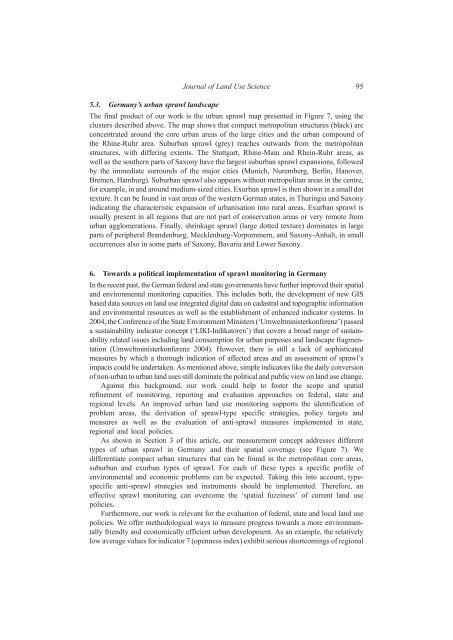PDF 20.134kB - TOBIAS-lib - Universität Tübingen
PDF 20.134kB - TOBIAS-lib - Universität Tübingen
PDF 20.134kB - TOBIAS-lib - Universität Tübingen
Erfolgreiche ePaper selbst erstellen
Machen Sie aus Ihren PDF Publikationen ein blätterbares Flipbook mit unserer einzigartigen Google optimierten e-Paper Software.
Journal of Land Use Science 95<br />
5.3. Germany’s urban sprawl landscape<br />
The final product of our work is the urban sprawl map presented in Figure 7, using the<br />
clusters described above. The map shows that compact metropolitan structures (black) are<br />
concentrated around the core urban areas of the large cities and the urban compound of<br />
the Rhine-Ruhr area. Suburban sprawl (grey) reaches outwards from the metropolitan<br />
structures, with differing extents. The Stuttgart, Rhine-Main and Rhein-Ruhr areas, as<br />
well as the southern parts of Saxony have the largest suburban sprawl expansions, followed<br />
by the immediate surrounds of the major cities (Munich, Nuremberg, Berlin, Hanover,<br />
Bremen, Hamburg). Suburban sprawl also appears without metropolitan areas in the centre,<br />
for example, in and around medium-sized cities. Exurban sprawl is then shown in a small dot<br />
texture. It can be found in vast areas of the western German states, in Thuringia and Saxony<br />
indicating the characteristic expansion of urbanisation into rural areas. Exurban sprawl is<br />
usually present in all regions that are not part of conservation areas or very remote from<br />
urban agglomerations. Finally, shrinkage sprawl (large dotted texture) dominates in large<br />
parts of peripheral Brandenburg, Mecklenburg-Vorpommern, and Saxony-Anhalt, in small<br />
occurrences also in some parts of Saxony, Bavaria and Lower Saxony.<br />
6. Towards a political implementation of sprawl monitoring in Germany<br />
In the recent past, the German federal and state governments have further improved their spatial<br />
and environmental monitoring capacities. This includes both, the development of new GIS<br />
based data sources on land use integrated digital data on cadastral and topographic information<br />
and environmental resources as well as the establishment of enhanced indicator systems. In<br />
2004, the Conference of the State Environment Ministers (‘Umweltministerkonferenz’) passed<br />
a sustainability indicator concept (‘LIKI-Indikatoren’) that covers a broad range of sustainability<br />
related issues including land consumption for urban purposes and landscape fragmentation<br />
(Umweltministerkonferenz 2004). However, there is still a lack of sophisticated<br />
measures by which a thorough indication of affected areas and an assessment of sprawl’s<br />
impacts could be undertaken. As mentioned above, simple indicators like the daily conversion<br />
of non-urban to urban land uses still dominate the political and public view on land use change.<br />
Against this background, our work could help to foster the scope and spatial<br />
refinement of monitoring, reporting and evaluation approaches on federal, state and<br />
regional levels. An improved urban land use monitoring supports the identification of<br />
problem areas, the derivation of sprawl-type specific strategies, policy targets and<br />
measures as well as the evaluation of anti-sprawl measures implemented in state,<br />
regional and local policies.<br />
As shown in Section 3 of this article, our measurement concept addresses different<br />
types of urban sprawl in Germany and their spatial coverage (see Figure 7). We<br />
differentiate compact urban structures that can be found in the metropolitan core areas,<br />
suburban and exurban types of sprawl. For each of these types a specific profile of<br />
environmental and economic problems can be expected. Taking this into account, typespecific<br />
anti-sprawl strategies and instruments should be implemented. Therefore, an<br />
effective sprawl monitoring can overcome the ‘spatial fuzziness’ of current land use<br />
policies.<br />
Furthermore, our work is relevant for the evaluation of federal, state and local land use<br />
policies. We offer methodological ways to measure progress towards a more environmentally<br />
friendly and economically efficient urban development. As an example, the relatively<br />
low average values for indicator 7 (openness index) exhibit serious shortcomings of regional

















